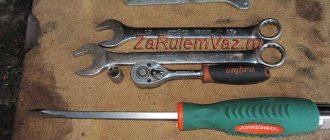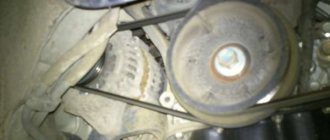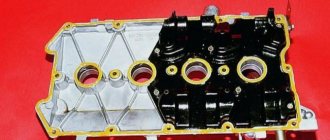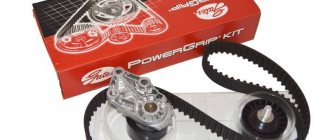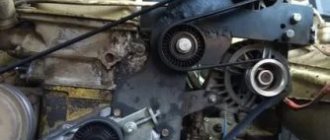Possible causes of malfunction
If the alternator belt creaks, then this sound hurts the ears not only of the driver and passengers, but even passers-by. When such sounds occur, the thought arises that the reason is in the strap and it needs to be replaced urgently, but this is not always the case. Therefore, before rushing to replace it, you should understand the cause of the squeak.
A generator is present in any car; its purpose is to provide electricity to all car systems. Continuity of rotation of the device rotor is ensured by a belt drive between the crankshaft and the generator. Due to friction with the pulley or slipping of the rubber product, a whistle occurs. Pulleys and belts may differ for different vehicle devices, but the principle of their interaction is the same. The cause of the squeak is the friction of parts from each other. Therefore, the whistle often occurs when the belt is loose and it slips along the pulley.
The cause of the squeaking of the alternator strap may be:
- insufficient tension;
- low quality product;
- traces of oil, coolant and various contaminants;
- distortion of the tensioner.
In the cold season, a squeak may occur when starting a cold car. The belt is a rubber product; in the cold it hardens and loses elasticity. As soon as the material warms up, the whistle disappears. The cause of the whistling may be increased humidity. In this case, nothing needs to be done, since the whistle disappears as the surface dries.
Whistling due to liquids
Most often, the timing belt begins to howl after oil or other liquid gets on it. Oil gets in, for example, due to faulty seals or a problematic motor.
Water got on the timing belt
Increased atmospheric humidity can also cause the belt to whine. Foggy weather in the autumn-spring period, rain and slush are ideal conditions for the occurrence of high humidity.
Article on the topic: How to install an additional interior heater for UAZ “Patriot”
Once on the plane of the belt, water kills the friction properties of the rubber.
As you know, whistling from moisture can be short-term, but the car owner does not need to amuse himself with this. One way or another, the belt will have to be replaced, as it has lost its original qualities. In some cases, tension can help, but with severe wear this is not the case.
It is important to understand that rain or high humidity are only indirect reasons. The real ones lie much deeper, indicating damage to the drive.
Fixes
What to do if you hear a squeaking sound from the generator belt? You shouldn't change it right away. Sometimes there is a whistle, but the resource of the consumable has not yet been exhausted and it can be further used. Therefore, if extraneous sounds occur, you should inspect the belt drive and find out where the squeak comes from. To diagnose, open the hood and inspect the strap for:
- integrity of the part;
- degree of wear;
- presence of traces of working fluids on the surface;
- displacement of the pulley line, they must be strictly on the same line;
- degree of tension of the product.
Replacement should be done if the surface is worn out, there are cracks, assemblies, or frayed edges. If traces of oil, coolant or other contaminants are found, you can try cleaning the surface. Contamination prevents the product from stretching and moving evenly. If they cannot be removed, the consumable must be replaced.
Replacing consumables
The cause of a whistling noise in the generator belt drive may be wear of the bearing in the tension roller or generator. To diagnose the serviceability of the tension roller, you need to dismantle it and check for defects and play. If any malfunctions are found, parts must be replaced.
You should buy only original products, this can guarantee that they will last the required period.
The following factors influence the service life of components:
- terms of Use;
- driver's driving style;
- degree of load;
- product quality;
- correct installation.
The most common cause of whistling is poor belt tension. To check it, you need to press the product between the generator and crankshaft pulleys somewhere near the middle.
Checking product tension
The deflection should be in the range from 6 to 8 mm. If the tension is not correct, it needs to be adjusted. If the tension is poor, the unit does not produce a full charge. To tension you need to do the following:
- Open the car hood.
- Loosen the generator mounting nut.
Generator mounting nut
- After this, the mechanism takes its original position, due to which the product weakens.
- In order to move the generator towards the engine compartment, you can use the pry bar as a lever.
- By moving the device using the lever, we adjust the degree of belt tension.
- Check the tension by hand. If the strap is tensioned as required, fix the position of the generator by tightening the fastening nut. It’s also not worth over-tightening, as the bearings will wear out faster due to the heavy load.
Move the unit towards the engine compartment
After the tension adjustment procedure, you need to check the operation of the unit. Before starting the engine, you need to turn on several devices powered by the generator, for example, a heater, air conditioning, and high beams. If everything is in order, then there is no whistle and the charging level is at the proper level.
Methods for eliminating noise
The noise that appears immediately after starting the engine can be eliminated in several ways. All of them will be discussed in detail below.
Lubrication
As mentioned above, lubrication of the element, although not for long, eliminates the whistling and noise of the strap. This is the most popular solution to the problem if a whistle appears after installing a new belt.
The lubricant in this case is a special type of aerosol, sold in every store. In addition, the universal VD-40 is also suitable for these purposes.
Step-by-step instructions for lubrication:
- You need to open the hood of the car.
- Remove the protective cover secured with bolts.
- Start the engine.
Note. Lubricating the elements of the hydraulic lubrication mechanism on a running engine is much more effective than on a stationary internal combustion engine. Yes, this will require some skill, which boils down to the fact that you need to be able to aim accurately and get the liquid onto the inner parts of the strap.
- You need to lubricate for 5-10 seconds, so that this time is enough to process all the belt teeth.
- Then you need to turn off the engine, put the cover back in place and check for noise.
Leak and its elimination
The first reason for an oil leak lies in the cylinder head gasket. If it breaks through, it provokes timing belt noise. Surely, if oil or liquid gets on the belt, noise starts.
Here's what to do:
- Check the cylinder head for leaks.
- If the top deviates from the BC even by a small distance, you should remove the head and grind it.
- Be sure to replace the gasket, since in most cases it is the reason for lubricant leakage.
If there is an antifreeze leak:
- Diagnose the area where the cylinder head comes into contact with the block. Most likely, coolant penetrates into the internal combustion engine due to a broken cuff. It is also recommended to check all attachments, including hoses and fittings. They should not be worn out, and nothing should leak from anywhere.
If other fluids are leaking:
- If a coolant or car air conditioning fluid leaks, first of all, possible leak locations are diagnosed. With a functioning internal combustion engine, it will be useful to diagnose the GDS mechanism, and if it does not help identify the cause, disassemble the mechanism and remove the belt.
Belt wear
The GDS belt of the mechanism ensures synchronous rotation of the shafts, ensuring timely opening/closing of the valves. A worn belt will eventually break, but it can function in semi-working condition for some time. This can also explain the whistle or other noise coming from the GDS mechanism.
Below are common signs that your belt is wearing out.
- If the belt looks “shaggy” in appearance.
- Micro- or macrocracks are visible on the belt.
The main traces of “aging” of the timing belt can be seen on the reverse side of the product. This very jagged inner part bears traces of dirt or the result of poor road conditions.
In order to somehow increase preventive measures for caring for the belt, you should periodically monitor the condition of the protective casing. It is from here that, if the lid is not closed well, most of the dirt and dust gets in. It is important to understand that the integrity of the protective casing is the reliability of the belt and its long service life.
There are also indirect signs of belt wear. For example, one of these signs involves wear on the drive belt. In this case, knowing about the similarity of both resources and their approximately equal wear, the owner diagnoses the drive belt. If the latter looks clearly worn out, then almost 90 percent of the time one can also judge that the timing belt is worn out.
Roller wear
When noise appears from the timing belts, it is imperative to identify the cause. But various components and installations can make noise, there are many of them, how can we determine for sure that it is NTZ?
An endoscope is an excellent and very useful tool for checking the characteristic noise of various properties. Sound mesomerism, in most cases, is diagnosed with a screwdriver or a metal rod, but you can do without it using modern endoscopes.
Video “Eliminating alternator belt whistling”
This video shows how to get rid of strap whistling using special liquids.
An unpleasant high-pitched whistle periodically coming from under the hood of a car indicates a problem with the belt drive. As a rule, a loud squeak is heard when starting the engine or when pressing the accelerator pedal. Moreover, at idle speed and during uniform movement, the sound does not appear. In most cases, you yourself will be able to determine why the alternator belt whistles “when cold” and when the engine “spins up”. There are several reasons, and half of them can be eliminated by the car owner.
Why does the timing belt make noise (whistle) when hot?
Reader question: Good afternoon. Engine A20DTH (160 hp). The problem is this: after the engine warms up, at idle speed, an extraneous rustling noise is heard in the timing belt area. When the speed increases, the noise is not audible. The noise appears only at idle and when the engine is fully warmed up, i.e. if the engine temperature is less than 90 and the speed is idle, then there is no noise. Two weeks ago, the OD had the timing belt and rollers replaced under warranty (cyclical shuffling on a cold engine). When cold, it now works like a charm - without any extraneous sounds, but it rustles when it’s hot. What is the reason?
The GDS belt of the mechanism ensures synchronous rotation of the shafts, ensuring timely opening/closing of the valves. A worn belt will eventually break, but it can function in semi-working condition for some time. This can also explain the whistle or other noise coming from the GDS mechanism.
Below are common signs that your belt is wearing out.
- If the belt looks “shaggy” in appearance.
- Micro- or macrocracks are visible on the belt.
The main traces of “aging” of the timing belt can be seen on the reverse side of the product. This very jagged inner part bears traces of dirt or the result of poor road conditions.
In order to somehow increase preventive measures for caring for the belt, you should periodically monitor the condition of the protective casing. It is from here that, if the lid is not closed well, most of the dirt and dust gets in. It is important to understand that the integrity of the protective casing is the reliability of the belt and its long service life.
There are also indirect signs of belt wear. For example, one of these signs involves wear on the drive belt. In this case, knowing about the similarity of both resources and their approximately equal wear, the owner diagnoses the drive belt. If the latter looks clearly worn, then almost 90 percent of the belt can also be judged to be worn.
Causes of problems
If you have encountered a similar phenomenon, you have probably noticed that the belt begins to make an annoying squeak at moments of greatest load. The whistling sound accompanies the friction of rubber on metal as a result of slipping of the belt drive. In 90% of cases, this indicates wear of the belt, which is a consumable item and needs to be periodically replaced (interval from 20 to 60 thousand km, depending on the make of the car).
Now more about the reasons for slippage:
- Stretching during operation, loosening of tension. The element begins to sag, and when the load increases, it begins to squeak.
- Critical wear of the belt: the working surface becomes covered with cracks, threads come out on the sides, it is impossible to achieve normal tension.
- You purchased and installed a “consumable” made of low quality rubber. Such products quickly stretch, and the working surface is “licked”.
Practice shows that low-quality products and fakes whistle even at maximum tension. As experienced drivers say, the material contains more soot than rubber.
Whistling often occurs for other reasons that do not depend on the quality and technical condition of the belt:
In the design of some cars (for example, Chevrolet Niva), a belt drive additionally rotates the shafts of the air conditioning compressor, water pump and power steering pump. If the oil seal or bearing of any of the listed units fails and lubricant gets on the pulleys, the belt will begin to slip and squeak.
Whistle when the air conditioner is turned on
This whistle has the most unpleasant consequences. The fact is that it does not always indicate the timing belt. He may have nothing to do with it at all.
Article on the topic: Battery VAZ 2114
Belt whistles, what should I do?
Given the variable load on the generator, it is most likely that the belt is slipping on the shaft roller due to the load. Solution: the belt is tightened, which quickly eliminates the whistling noise. But if the noise remains, it means the problem is in the air conditioner.
Obviously, there is little pleasure in a malfunctioning air conditioner. If the compressor is damaged, the least you can do is change the oil. But this solves little, since in most cases you have to check all the bearings, change the freon, etc.
Whistle when starting the engine
When one or more of the above problems occurs, the first thing that appears is the whistling of the alternator belt when the engine is cold. This happens for the following reasons:
- Cooled lubricant thickens and becomes viscous (especially in winter), so more force must be developed to turn the generator shaft. A loose or worn belt will slip and squeak at this moment.
- If the drive rotates the power steering pump, compressor and pump, then the resistance of the thickened lubricant increases. A small amount of sagging or liquid getting on the pulley is enough for the belt to start slipping.
- At the time of startup and the first minutes of operation of the internal combustion engine, an increased load is placed on the generator. The electromagnetic field of the stator creates resistance to shaft rotation.
A “cold” squeak is the first symptom of a belt drive malfunction. If you do not diagnose the problem and do not take measures to eliminate it, the drive will begin to squeak even on a warm engine, when you press the gas pedal.
Functions of the timing belt
The internal combustion engine is equipped with a gas distribution mechanism. Its task is to fill the cylinders with the fuel mixture in a timely manner, as well as remove gases from them. To do this, the gas distribution mechanism opens and closes the intake and exhaust valves, which are on all engine cylinders, at the right time.
The camshaft is also involved in the work; it regulates the operation of the valves. The gas distribution mechanism on all cars consists of the above elements. The operation of the camshaft is possible if the crankshaft transmits torque to it. This requires a drive. It consists of pulleys located on the camshaft and crankshaft, and a belt with which the pulleys are connected.
This is the timing belt. That is, thanks to this part, the camshaft and crankshaft work synchronously. In addition, in some modern internal combustion engines, the timing belt forces the water pump to work. Typically, internal combustion engine manufacturers place timing belts between the radiator and the cylinder block, in the front part of the engine compartment.
Read more: Characteristics of the ignition coil on Lada Priora, recommendations for checking and replacement
On some car models, you will see the timing belt as soon as you lift the hood. But sometimes it is covered with a casing. One way or another, finding this part will be easy. What does a timing belt look like? It is made in the form of a closed rim. There are teeth on its inner surface. Note!
There are no straps on sale that are suitable for any car. Different timing belts are available for different engines. What could this part be made of? Previously, they were made from rubber with textile cord. Modern parts are made from ultra-strong fiberglass, as well as polymer compounds that are not afraid of temperature changes.
Of course, the timing chain is still stronger than the belt. But modern timing belts are wear-resistant, durable, and their service life is quite long. However, there are often cases when this part becomes unusable before the specified period or breaks. In order for the car to always be on the move, it is necessary to monitor the condition of the main components.
“The timing belt broke: who is to blame and what to do?” More details
Troubleshooting
Next, it’s worth considering what the owner of a car with a whistling alternator drive belt should do. It is recommended to immediately inspect the mechanism and find out whether it is possible to continue moving or whether it is necessary to immediately begin repairs. Diagnostics is performed as follows:
- Open the hood, remove the plastic protective cover from the engine (if it is in the way) and carefully inspect the belt drive for water or process fluid. It happens that the drive gets wet after driving through deep puddles.
- If an oily liquid is found, not only on the belt, but also on the cylinder block, try to find its source. Carefully inspect the pump, power steering pump and air conditioning compressor - all units located next to the drive.
- When inspecting, pay attention to the engine gaskets so that oil does not leak from under them.
- Make sure that the belt is not cracked and that there are no threads on the sides.
- Check the tension using the vehicle's operating instructions. A universal method is to rotate the free section of the belt around the longitudinal axis. The tension is considered satisfactory when the element rotates no more than 90°.
Remedies
Finally, a few words about how to eliminate the whistling of the alternator belt. The method depends on the cause of the malfunction:
- a worn element, covered with cracks and unable to be stretched, should definitely be replaced;
- If water or antifreeze gets in, wipe the drive parts thoroughly;
- traces of liquid lubricants must be removed with a rag moistened with a degreaser, and it is recommended to remove the belt in order to wipe the pulleys;
- a loose belt drive should be tightened.
Before removing traces of operating fluids from drive parts, it is necessary to eliminate the cause of their leakage, otherwise such work is pointless. The leaking pump is replaced entirely, and a new oil seal is installed in the power steering pump. If the generator bearing is found to be seized, the unit will have to be dismantled and taken to an auto electrician for restoration.
A belt with a “licked” surface can be briefly extended its service life using the old-fashioned method. Take a piece of soldering rosin and rub the work surface thoroughly. The procedure is performed at idle speed of the engine, observing safety measures: rosin is applied to the inside of the rotating belt. After the operation, the element will acquire adhesion to the pulleys, allowing you to drive without whistling.
The alternator belt is a structural element of the engine that transfers mechanical energy from the crankshaft to the generator, which, in turn, converts it into electricity. The interaction between the generator and the crankshaft is ensured by a belt connection mounted on pulleys.
There are many designs for this system, but the principle of its operation always looks the same, and the problems that arise always have the same causes.
When a belt whistles or creaks, it usually indicates that one of the pulleys is slipping, resulting from excessive friction between the elements.
When you hear an unpleasant sound from under the hood, you don’t need to immediately run to the nearest service center or do anything rash. First of all, you need to check the engine yourself and figure out the problem - it’s quite possible that you can fix it on your own
The alternator belt whistles: what to do?
Finding a suitable solution to the problem should begin with identifying the problems causing the abnormal sounds. The reasons for a whistling alternator belt can be different.
:
- when using an old and worn belt, it is almost impossible to tension it to a normal value, which becomes the cause of an unpleasant sound;
- a cheap belt made of poor material may initially produce a characteristic creaking or whistling sound;
- when technical fluid gets on the belt or pulleys, the belt slips, which also causes extraneous sound;
- A generator bearing worn out after working in difficult conditions can also make unpleasant sounds.
Of course, there may be other reasons for whistling or other sounds coming from the engine compartment, but those described above are much more common.
You need to understand that a car consists of a huge number of systems that must work together
In any case, the system must be thoroughly tested before making a final verdict. To do this you need to do the following:
1. First you need to find out whether the belt is intact and whether there is any visually noticeable damage on it. The phenomenon is quite common and occurs when the car is used for a long time without replacing the belt.
2. Next, check the belt tension level (even a good, but poorly tensioned belt can cause a whistle). If such a symptom is present, not only a whistle may be noticeable, but also a slight decrease in the efficiency of the generator.
The timing belt is noisy after replacement - what to do?
Very often, after replacing the timing belt, owners of Renault and Lada Priora cars are faced with a problem: a rhythmic noise is heard in the timing belt area. In today's article we will figure out where this noise can come from, where to look for the cause of the problem and how to fix it without resorting to the help of specialists.
The GDS system stands out for its extremely complex structure. In order for it to periodically function in the correct mode, it is necessary to timely check and replace certain parts
Why does the alternator belt whistle?
The appearance of a whistle under the hood clearly indicates a problem with the belt.
. As a result, such a phenomenon can cause deterioration in the operation of the generator, compressors and pumps, the operation of which is ensured by the gas distribution mechanism. In addition to reducing engine performance, the whistling of the generator belt is unpleasant in itself - it can be heard from afar, and there is little pleasant in such a sound accompaniment.
How to eliminate a whistling alternator belt
First of all, it is worth noting that the whistling of the alternator belt is a fairly common phenomenon that can be eliminated without any problems.
First, a diagnosis is carried out to determine the exact cause of the extraneous noise.
Having figured out the cause of the whistle, you can begin to eliminate the problem:
1. If there is mechanical damage to the belt (frayed edges, cracks and tears) or noticeable wear, the belt clearly needs to be replaced. Belts for different cars can have significant differences, so you need to look for a part designed for a specific make and model of car (in extreme cases, you can choose an interchangeable part).
2. If the belt is dirty and traces of technical fluids can be seen on it, it must be cleaned and replaced in its place. There are cases when it is not possible to remove the contamination, and the belt continues to whistle after cleaning and reinstallation - in this case it should also be changed.
3. Visually noticeable damage is only one part of the problem. If a superficial inspection does not produce results, and the unpleasant sound when starting the engine is still present, then you need to check the degree of belt tension. To do this, just press the belt right in the middle and measure its deflection. The optimal value is about 7 mm (before checking, you should ask about the exact value of the belt deflection for your car). The discrepancy between values will have to be resolved.
4. Sometimes belt whistling occurs due to axial deviations of the pulleys relative to each other. Under normal conditions, both pulleys should be positioned strictly parallel, but there are situations when one of them moves and an unpleasant sound occurs. To correct the problem, you will need to align the pulleys.
5. Often the alternator belt begins to whistle for reasons beyond the control of the belt itself. Most often, this is caused by a damaged bearing, which not only causes the belt to whistle, but is also capable of distinctly crunching. If such a problem is detected, you should immediately change the bearing - the unpleasant sounds should disappear.
6. It is also worth noting that in winter, many car owners note an increase in belt tension. In this case, there is no need to sound the alarm immediately - when the engine warms up, the belt will return to working condition. To prevent this phenomenon, you can purchase special additives, the application of which to the surface of the generator belt and pulleys will increase their resistance to external factors.
Potential Noise Contributors
So, many car owners who complain about timing belt noise have noted that the belt whistles more often when the engine is cold. In other words, when starting the engine.
Fortunately or unfortunately, this kind of problem is very common. Below are the most common causes of belt noise.
- Wear of gas distribution system components. It is not surprising that those elements that work in tandem with the timing belt, after wearing out, no longer cope with their tasks as before. For example, if the teeth of the shaft wheels are worn out.
- The belt itself has worn out, or rather, its teeth. In this case, it is already customary to talk not about the whistling of the belt after replacement, but about the noise of a worn-out product. Definitely, replacing the belt with a new element will help solve this problem if there are no other faults.
- Weak tension. If the HTZ roller is faulty or the tension is weak, the timing belt may whistle.
- The belt may also make noise if it gets grease or other compounds on it. For example, if a noise appears when the power plant is starting up when it is cold, this usually indicates a leak of coolant or lubrication of the internal combustion engine.
Brake fluid may also get on the belt for some reason. Also, aggressive liquid can get into the mechanism of any shaft disk.
- A whistle that appears immediately after replacement may also indicate poor quality of the product. Most likely, this belt was purchased for little money. Only replacing the belt with a better version will help, and nothing more.
Note. In some cases, the belt is lubricated, and then it no longer whistles, but only for a certain time. Then the “pandemonium” noisily begins again.
- Belt noise is also possible due to wear on the roller. If it has already served its service life and has not been replaced along with the belt, the whistle is its consequences. To eliminate the noise, you will have to replace the roller.

